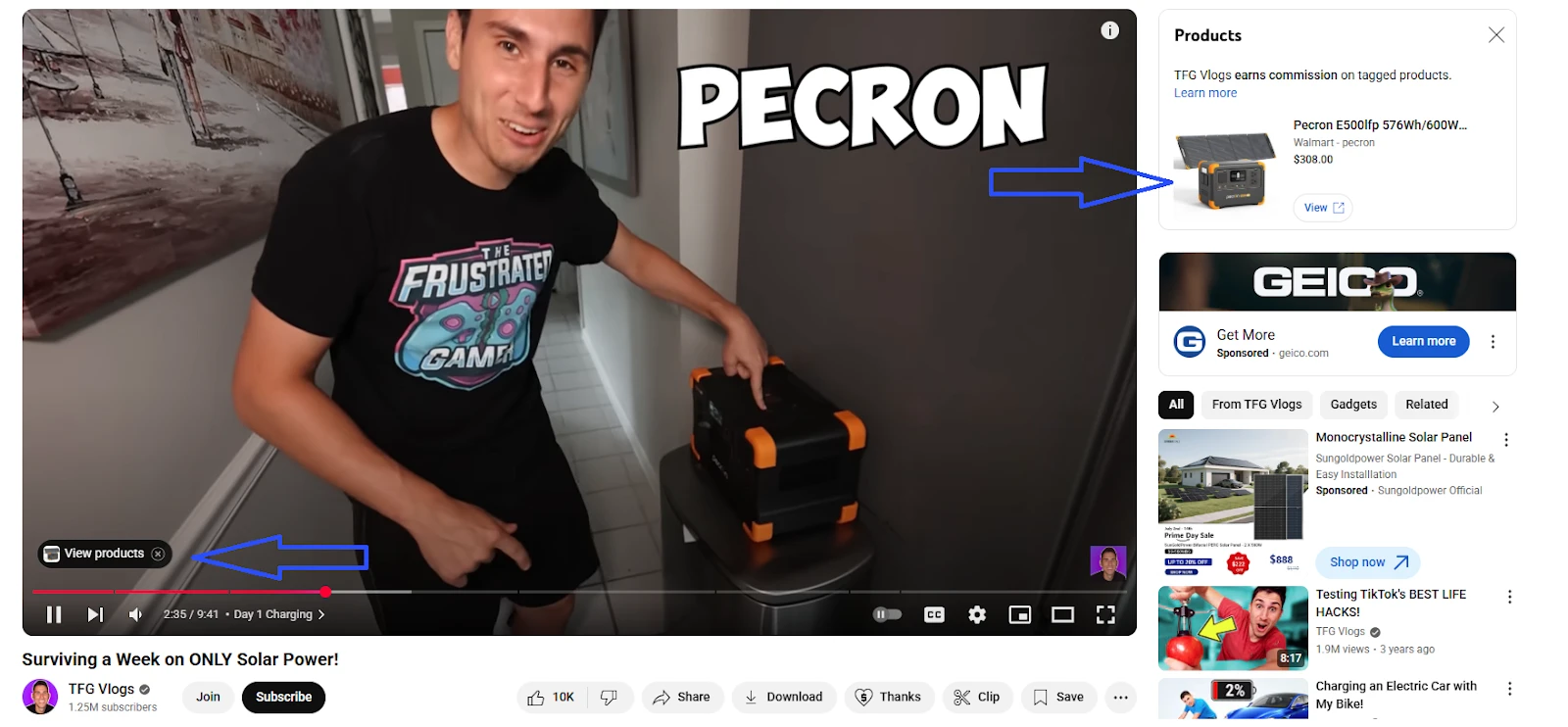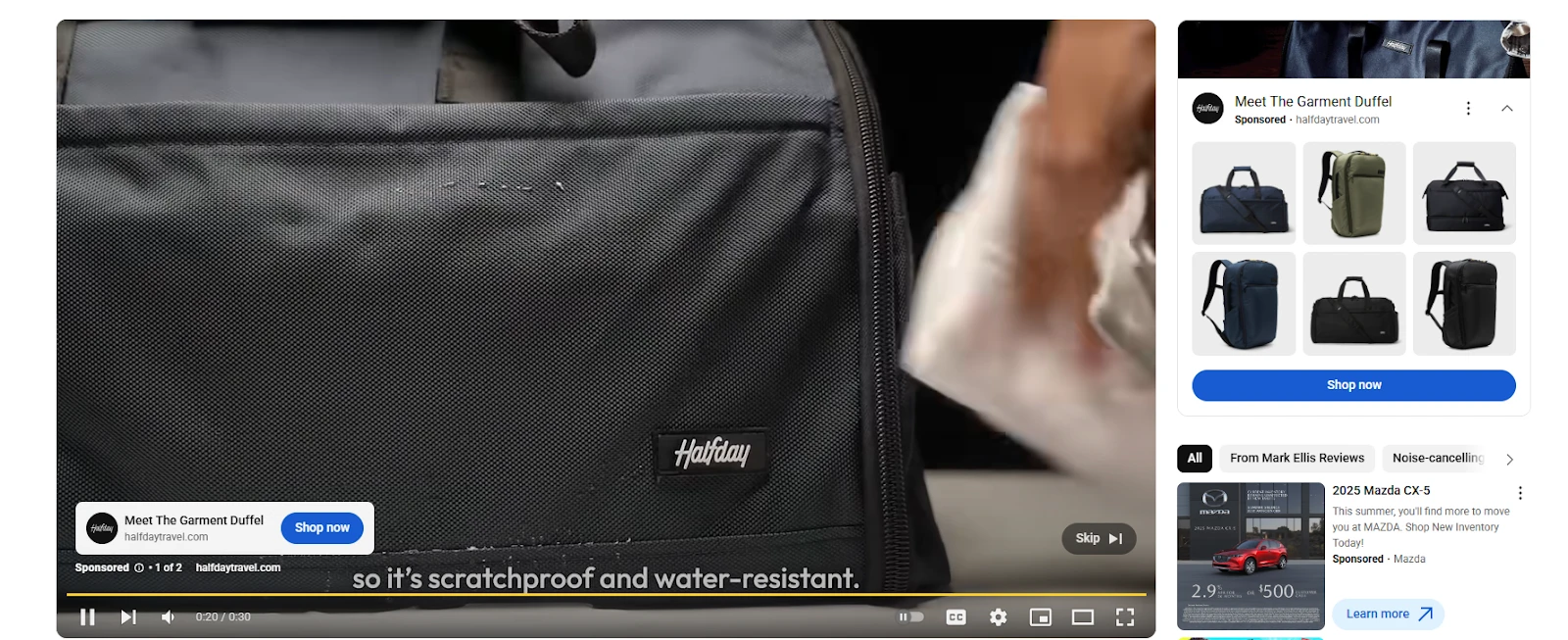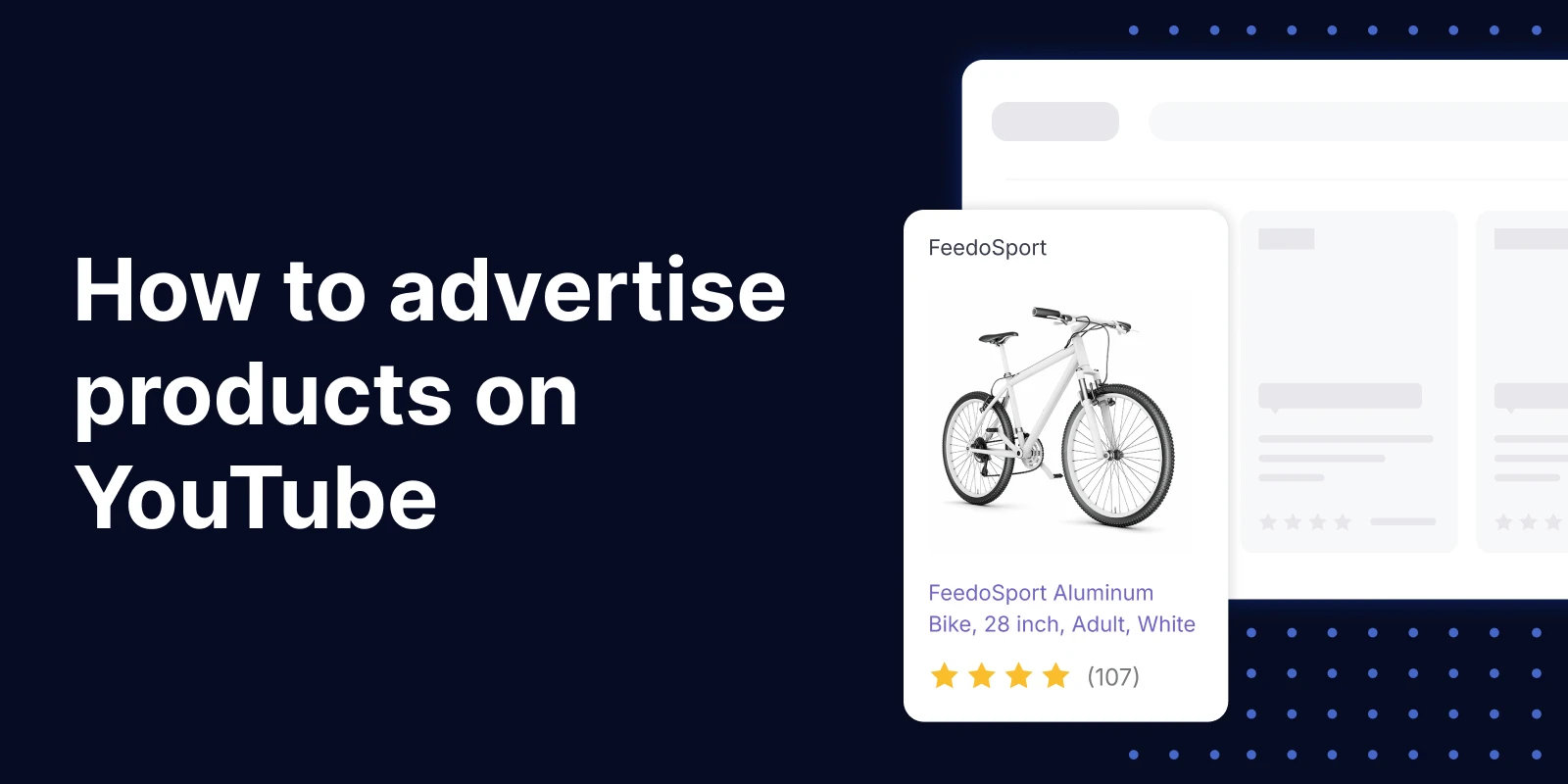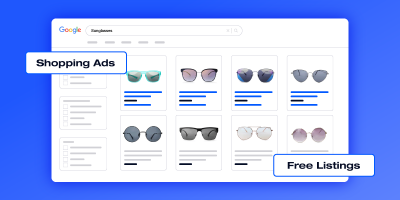With more than 2 billion monthly logged-in users and 70 billion daily views on Shorts alone (yes, that’s BILLION, with a big, beautiful ‘B’), YouTube is a great channel to reach a large, highly-engaged audience.
Powered by Google’s ad tech, products are embedded directly in YouTube videos, allowing users to go from inspiration to purchase while watching their favorite creators. YouTube’s commerce capabilities—especially when combined with enriched product feeds in Google Merchant Center—enable brands to activate this potential at scale and get better results.
YouTube videos that include product tags and descriptions generate 23% more clicks than those relying on standard description links, and according to Google, advertisers see 33% more conversions on average by using a product feed for their YouTube Demand Gen campaigns. So, it’s proven that the way products are presented—particularly with structured and enriched product data—dramatically influences engagement and sales.
In this blog, we walk you through the various advertising options available to you on YouTube, including the YouTube Shopping affiliate program and Demand Gen campaigns, how YouTube uses product feeds, and what you can do to improve your ad performance.
Advertising options on YouTube with GMC product feeds
If you’re a seller with a Google Merchant Center (GMC) product feed, YouTube offers multiple ways to advertise products from your catalog, both on videos and on other parts of YouTube pages.
With the YouTube Shopping affiliate program, YouTube creators can tag your products in their content, like Shorts, videos, and livestreams. You only pay a commission when they drive a sale.

Here is an example of a YouTube Shopping affiliate ad in action. YouTuber TFG Vlogs has tagged a solar panel in his video titled “Surviving a Week on ONLY Solar Power!” Interested viewers can be taken to the product page by clicking on the “View products” tag on the bottom left within the media player, or the larger “Products” section on the top right of the page.
With Demand Gen campaigns, you can serve dynamic, product-powered ads across YouTube, Shorts, Discover, Gmail, and the Google Display Network. These ads can include video, image, or carousel formats enhanced with real-time product data from your Google Merchant Center feed, allowing you to show shoppable product tiles directly beneath or beside your creatives.

Here is an example of a Demand Generation campaign in action. A skippable ad plays before the YouTube video starts, featuring the brand’s products. Additionally, a “Shop now” button is shown on the bottom left of the media player, and on the top right, a dynamic product feed carousel displays shoppable products from the brand’s Google Merchant Center feed.
In both cases, your Google Merchant Center product feed is the engine behind visibility, engagement, and conversion.
How to list products on YouTube Shopping affiliate and Demand Gen
A product feed is a structured data file that contains key information about your product catalog, such as titles, images, prices, availability, and links.
YouTube doesn’t host its own product catalog; instead, feeds are submitted through Google Merchant Center (GMC).
By syncing a product feed through GMC, brands can enable dynamic, shoppable product placements across a variety of YouTube surfaces—such as beneath video ads, alongside in-feed placements, or within interactive carousels—depending on the campaign type and creative format.
Once your GMC feed is configured, you’ll be able to activate your product catalog:
- GMC syncs the feed with Google Ads or Display & Video 360
- Product data is rendered dynamically in YouTube ad units or affiliate-tagged videos
- Feeds update automatically when connected through tools like Feedonomics or scheduled via GMC fetch or Content API to reflect changes in inventory, pricing, or imagery
Organic tagging vs. ad-based feeds
YouTube supports two core methods of product integration, both of which rely on product feeds but differ in how they’re activated and who controls them. This determines the kind of visibility and performance reporting you can expect from each method.
| Feature | YouTube Shopping affiliate program | Demand Gen campaigns |
|---|---|---|
| Surface | Organic creator content (videos, Shorts, live) | Paid placements across YouTube Shorts, feeds, Watch Page, Gmail, Discover, GDN |
| Format | Product tags embedded in creator videos, shorts, and livestreams | Video ads, image ads, product feed carousel ads |
| Who activates it | YouTube creator (affiliate) | You (the advertiser) |
| Cost model | Commission-only (performance-based) | CPM, CPA, or tROAS bidding |
| Setup | Merchant Center + affiliate program opt-in | Merchant Center + campaign setup |
Grow ecommerce sales with Feedonomics and YouTube
Use cases for product feeds on YouTube: Affiliate and Demand Gen campaigns
Here’s a more in-depth explanation on what each YouTube product advertising method has to offer and the role your product feed plays in the success of your advertising efforts:
YouTube Shopping affiliate program
The YouTube Shopping affiliate program lets creators tag products from participating merchants directly in their regular videos, Shorts, and livestreams. These tags appear seamlessly within content, allowing viewers to browse and purchase products without leaving the platform.
Merchants upload their product data feed through Google Merchant Center, which is then made available to approved creators. These creators can browse and tag eligible products in their content, turning each video into a curated, shoppable experience.
One of the most attractive features of this program is its performance-based pricing. Merchants only pay commissions when a tagged product leads to a purchase—no upfront media spend required. This risk-free model makes it easy for brands to scale their reach while maintaining control over costs.
Why sellers should use YouTube Shopping affiliate:
- Increased exposure: Featuring your products in creator content boosts visibility across high-intent audiences that trust and engage with their favorite YouTube channels. In 2022, YouTube boasted 150 billion shoppable views over the course of the year.
- Creator amplification: Unlocks influencer reach without the need for separate contracts or one-off product integrations.
- Low-risk model: Because you only pay commissions on actual sales, the affiliate program offers a cost-effective way to scale your reach with minimal upfront investment.
- Performance insights: Merchants manage content, products, and performance directly from Google Merchant Center.
Feedonomics facilitates this process by ensuring product feeds are eligible, optimized, and always up-to-date for affiliate tagging.
Source: Google
Demand Gen campaigns
Demand Gen is Google’s next-generation campaign type designed for visually immersive, multiformat advertising. Unlike traditional Shopping or Search campaigns, Demand Gen enables brands to showcase image, video, and carousel creatives across some of Google’s most attention-rich platforms—all within a single campaign.
What sets Demand Gen apart is its deep integration with your Google Merchant Center product feed. You can personalize which products appear, control how they’re displayed, and combine them with videos or branded creatives to deliver scroll-stopping shopping experiences. These campaigns are served across:
- YouTube Shorts
- YouTube Discover
- YouTube Watch Page and In-Feed
- Gmail Promotions Tab
- Google Display Network
This unlocks access to over 3 billion monthly users across some of the most immersive and attention-rich platforms.
Demand Gen campaigns allow you to:
- Use product filters and custom labels to highlight the most relevant items from your feed.
- Create lookalike audiences to reach new users who resemble your high-value customers.
- Leverage Google AI to optimize bidding, creative combinations, and placements based on real-time intent signals.
- Run multiformat ads (videos, images, and carousels) within a single campaign.
- A/B test assets and creative to find the highest-converting combinations.
- Preview ads before launch to see how each variation appears across YouTube and Google surfaces.
Why advertisers should use Demand Gen for YouTube campaigns:
- Reach buyers early in their journey: Demand Gen surfaces your products where users browse, watch, and discover—before they start actively searching
- Visual storytelling with shopping intent: Blend branded storytelling with direct response formats to drive both interest and sales
- Seamless product integration: Attach your Google Merchant Center feed and serve shoppable carousels below video ads or alongside image placements
- Smarter scaling with AI: Google’s algorithms handle creative testing and bidding to help you scale cost-efficiently across placements
- Unified reach with multichannel impact: Extend your feed-powered ads beyond YouTube into Discover, Gmail, and the Display Network—all from a single campaign
While Google Shopping campaigns also use product feeds, they don’t appear on YouTube—only Demand Gen campaigns support video ads with product carousels across YouTube surfaces.
According to Google, on average, advertisers see 33% more conversions at a similar cost per action (CPA) and 18% more clicks by adding product feeds to Demand Gen campaigns.
Video Action campaigns
Advertisers can use product feeds in YouTube Video campaigns to convert traditional video ads into shoppable formats. When a user views the ad—especially in mobile portrait mode or on desktop—a panel expands beneath the video, showcasing a carousel of products.
When feeds are added to a video campaign:
- A product panel appears below the video on mobile (portrait mode).
- On desktop, product tiles appear next to the ad or within the YouTube interface.
According to Google, adding a product feed to a Video Action campaign increases conversions by over 60% while lowering cost-per-acquisition (CPA). This makes product feeds one of the most impactful creative add-ons for YouTube ads.
Best practices for YouTube campaigns using product feeds
To get the most value from your YouTube product feed campaigns—whether you’re targeting Shorts viewers or launching a Demand Gen initiative—strategic setup and execution are key. Below are proven best practices to boost performance, engagement, and ROI.
Best practices that apply to both Demand Gen and affiliate tagging on YouTube
1. Optimize product titles and images
Clear, compelling product titles and high-quality visuals help in both contexts:
- For Demand Gen: improves ad relevance and CTR
- For Affiliate: increases the chances creators will tag your products
2. Keep product attributes accurate
Inventory, pricing, and availability should always be current:
- For Demand Gen: ensures ads don’t promote out-of-stock or mispriced items
- For Affiliate: prevents creators from tagging unavailable or misrepresented products
3. Use custom labels and item_group_id
Labeling helps with segmentation and product grouping:
- For Demand Gen: enables product filtering and campaign structuring
- For Affiliate: improves organization and helps creators find variants (like sizes/colors)
4. Sync your feed regularly
Whether via Feedonomics or scheduled updates, fresh data ensures a seamless experience:
- For Demand Gen: keeps your campaign eligible and competitive
- For Affiliate: ensures creators always see your most up-to-date products
5. Use a feed management tool
Regardless of campaign type, a solution like Feedonomics helps automate:
- Feed formatting and compliance
- Product eligibility across surfaces
- Data enrichment and error resolution
Optimize your catalogs at scale with Feedonomics for Advertising
Best practices specific to the YouTube Shopping Affiliate program
These strategies help you increase the likelihood that creators will tag your products, maximize exposure, and ensure your feed remains eligible and appealing within the creator ecosystem.
1. Make your products content-creator friendly
Unlike paid campaigns, you don’t choose the placements—creators do. Your goal is to make your products attractive to them.
Tips:
- Use clear, easy-to-understand product names (avoid technical jargon or internal naming)
- Choose high-quality primary images that stand out visually
- Ensure product titles and thumbnails are instantly recognizable and relevant to creator audiences
2. Expand and diversify your product catalog
The broader your catalog, the more opportunities creators have to tag something relevant to their content.
- Include a full range of SKUs, including accessories, bundles, and variants
- Even low-volume or seasonal products may resonate with niche creator content
3. Ensure feed eligibility for affiliate tagging
To be taggable, your products must:
- Comply with YouTube Shopping and personalized ad policies
- Be in stock and meet image quality standards
- Have product pages with transparent pricing, return policies, and functional checkout
4. Leverage performance data in Google Merchant Center
Use GMC reports to identify:
- Which products are most frequently tagged
- What content types or creators are driving performance
- Trends that can inform catalog updates or seasonal promotions
5. Minimize approval lag for new products
Creators won’t wait for a product to become available in your feed. To stay competitive:
- Automate your feed updates (e.g., using Feedonomics or API connections)
- Prioritize fast syncs for new product drops, especially ahead of major campaigns or launches
6. Let creators sell naturally (no hard branding)
Avoid over-branding your product titles or images. Instead, focus on:
- Descriptive titles that align with how creators talk about the product
- Visuals that feel “native” to lifestyle or review content
- Optional: highlight products with social proof, UGC, or trending categories
Best practices specific to YouTube Demand Gen campaigns
These practices help you maximize performance, efficiency, and scalability in Demand Gen campaigns using your Google Merchant Center (GMC) product feed.
1. Upload a wide variety of creative assets
Demand Gen uses Google AI to test and optimize creative combinations across formats and placements. The more assets you provide, the more the system can learn.
Upload:
- Multiple video lengths (short-form, vertical, 16:9)
- Image assets (square, portrait, landscape)
- Headlines, descriptions, and CTAs
2. Enable product feed carousels for shoppable video ads
Add your GMC product feed to make your video ads shoppable. When done correctly:
- Product tiles appear beneath or beside your video
- Viewers can click directly into product pages
- Feed carousels are dynamically optimized for performance
3. Use audience-first targeting (not keywords)
Demand Gen doesn’t use search intent in the same way traditional Google Search or Shopping campaigns do.
Instead:
- Use lookalike segments based on site visitors, converters, or customer lists
- Target custom segments based on user interests or activity
- Use remarketing lists for mid-to-lower funnel retargeting
4. Take advantage of AI-powered bidding strategies
Let Google’s bidding engine optimize for your business goals:
- Maximize Conversions
- Target CPA (Cost per acquisition)
- Target ROAS (Return on ad spend)
You can adjust bidding strategies based on the campaign stage—use Max Conversions for testing, then layer in CPA or ROAS as performance stabilizes.
5. Run creative experiments and A/B tests
Demand Gen campaigns support creative experiments that let you:
- Test different video messages, thumbnails, or visuals
- Compare ad formats (carousel vs. single asset)
- Measure impact on conversions, clicks, or engagement
You can also run Brand Lift and Search Lift studies to measure brand awareness and purchase intent shifts.
6. Use feed filters and custom labels to segment products
Unlike affiliate campaigns, Demand Gen lets you control which products show up in which ad groups:
- Segment product groups by category, margin, or inventory level
- Use
custom_labelfields for seasonal groupings or promotions - Exclude low-performing SKUs or out-of-stock items
7. Preview and adjust ad placements
Before launching, use Google Ads’ preview tools to:
- Visualize how your ads will appear on YouTube Shorts, Discover, Gmail, etc.
- Confirm creative alignment across devices and formats
- Avoid layout mismatches or poor image cropping
Feedonomics for YouTube and Google Shopping product feeds
Success on YouTube doesn’t just depend on video creatives—it hinges on the quality, structure, and accuracy of your product data. That’s where Feedonomics comes in.
Partnering with YouTube’s Shopping affiliate program, Feedonomics helps merchants seamlessly connect their product catalog to Google Merchant Center, ensuring that listings are eligible, optimized, and dynamically updated across YouTube campaigns and surfaces.
Whether you’re enabling creators to tag products through affiliate links or launching scalable, AI-powered ad campaigns in Demand Gen, Feedonomics offers the infrastructure and support to make your product feed strategy a competitive advantage.
With Feedonomics, you get:
- Automated feed syncing to Google Merchant Center
- Feed transformation and enrichment to meet Google and YouTube requirements
- Proactive error detection and resolution to avoid disapprovals or downtime
- Multichannel integration with hundreds of ad channels and marketplaces
- 24/7 global support from a team of dedicated channel experts
Ready to power your YouTube Shopping and ad campaigns with optimized product data?
YouTube Shopping and Demand Gen FAQs
How can I connect my ecommerce platform to Google Merchant Center?
If you’re using an ecommerce platform like BigCommerce, Shopify, or another solution that supports product feeds, you can connect your store to Google Merchant Center to activate YouTube Shopping features—including product tagging, the Store tab, and shopping collections that appear across the YouTube app and video pages.
Depending on your platform, integration can be done through:
- A built-in Google channel or app (available on platforms like BigCommerce and Shopify)
- A feed management provider like Feedonomics for more advanced control, customization, and multichannel feed syncing
Once connected and approved, you’ll be able to feature your products in YouTube videos, Shorts, and livestreams, and make them discoverable across Google’s ecosystem.
How do I list products on a YouTube storefront (Store tab) using my product feed?
To list products on a YouTube storefront, such as the Store tab on your channel or product shelves beneath videos, you need to activate YouTube Shopping—not just Google Shopping ads.
Here are the steps:
- Create or connect a Google Merchant Center (GMC) account
- Make sure your product feed meets all Shopping and YouTube policies
- Link GMC to your YouTube channel via Google Ads
- Your Google Ads and Merchant Center accounts must be linked, and the YouTube channel must be associated with your Google Ads account
- Ensure your channel is eligible
- You must be part of the YouTube Partner Program
- Your content must not be marked “Made for Kids”
- You must be in a supported country (e.g., U.S., South Korea, India, etc.)
- Enable YouTube Shopping
- Go to YouTube Studio > Monetization > Shopping tab
- Connect your Merchant Center feed and select the products you want to show
- Set up your display preferences (Store tab, product shelf, etc.)
- Optional: Use a feed management solution (like Feedonomics) to sync and optimize your product data for YouTube Shopping visibility.
How does YouTube Studio help manage monetization and new product placements?
Within YouTube Studio, creators and retailers can monitor performance metrics, manage affiliate marketing settings, and control merch listings. If a new product is added to your online store, your Google Merchant Center feed will automatically update listings, ensuring your product shelf reflects accurate availability across your YouTube channel. Studio also alerts creators about community guidelines and monetization eligibility for new content.
How can eligible creators monetize their YouTube channel with shopping features?
Eligible creators enrolled in the YouTube Partner Program can activate YouTube Shopping features to promote merch or products from approved retailers. Through affiliate marketing or the product shelf, creators earn commissions when viewers purchase featured items. These monetization tools appear on the store tab, playlist pages, or below videos, depending on the channel setup and product eligibility.

Muhammed is a content marketing specialist creating informative content to help ecommerce professionals solve industry challenges and stay ahead of the curve.


